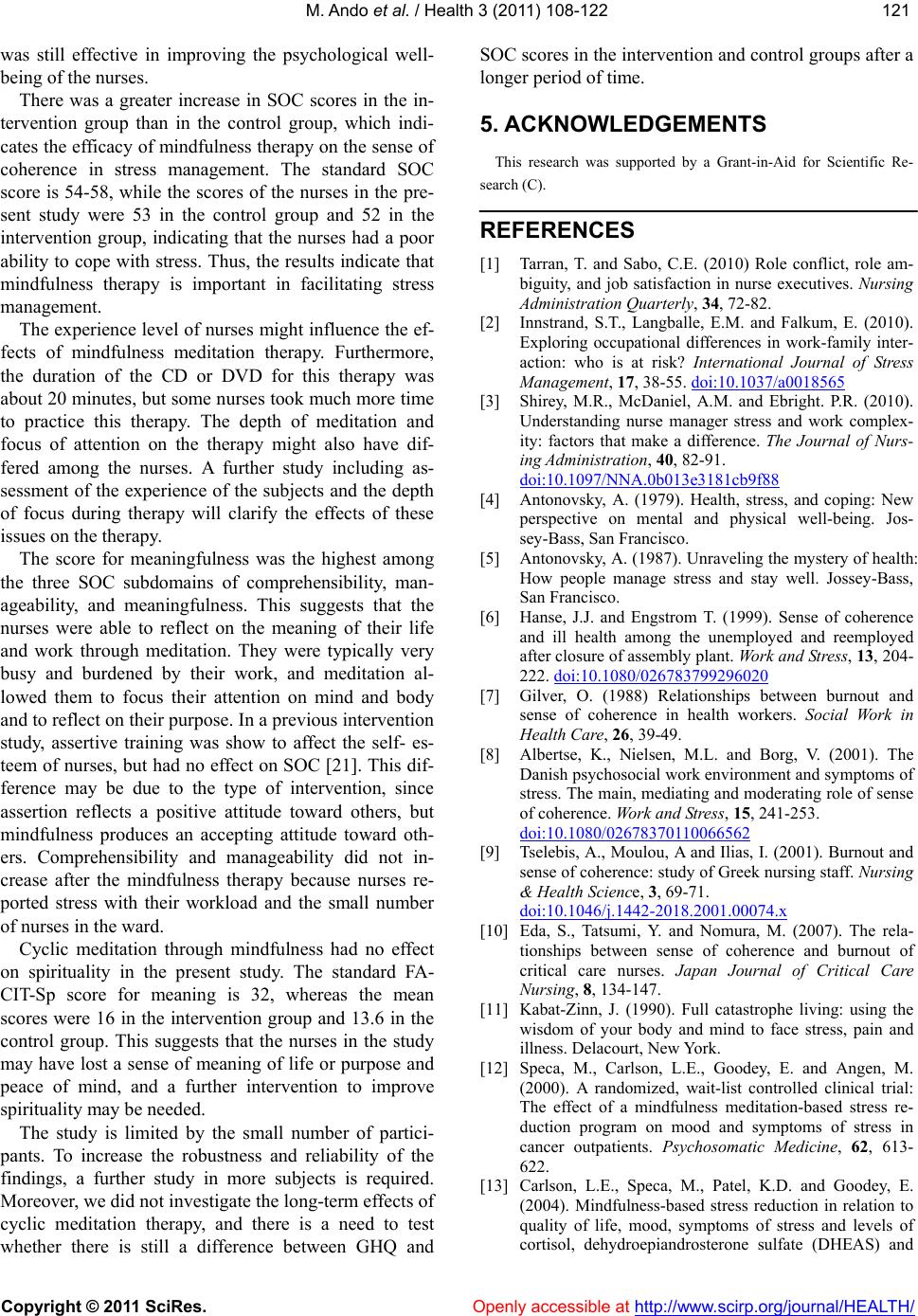
M. Ando et al. / Health 3 (2011) 108-1 22
Copyright © 2011 SciRes. Openly accessible at http://www.scirp.org/journal/HEALTH/
121121
was still effective in improving the psychological well-
being of the nu rses.
There was a greater increase in SOC scores in the in-
tervention group than in the control group, which indi-
cates the efficacy of mindfulness therapy on the sense of
coherence in stress management. The standard SOC
score is 54-58, while the scores of the nurses in the pre-
sent study were 53 in the control group and 52 in the
intervention group, indicating that the nurses had a poor
ability to cope with stress. Thus, the resu lts ind icate that
mindfulness therapy is important in facilitating stress
management.
The experience level of nurses might influence the ef-
fects of mindfulness meditation therapy. Furthermore,
the duration of the CD or DVD for this therapy was
about 20 minutes, but some nurses took much more time
to practice this therapy. The depth of meditation and
focus of attention on the therapy might also have dif-
fered among the nurses. A further study including as-
sessment of the experience of the subjects and the depth
of focus during therapy will clarify the effects of these
issues on the therapy.
The score for meaningfulness was the highest among
the three SOC subdomains of comprehensibility, man-
ageability, and meaningfulness. This suggests that the
nurses were able to reflect on the meaning of their life
and work through meditation. They were typically very
busy and burdened by their work, and meditation al-
lowed them to focus their attention on mind and body
and to reflect on their purpos e. In a pr eviou s interv en tion
study, assertive training was show to affect the self- es-
teem of nurses, but had no effect on SOC [21]. This dif-
ference may be due to the type of intervention, since
assertion reflects a positive attitude toward others, but
mindfulness produces an accepting attitude toward oth-
ers. Comprehensibility and manageability did not in-
crease after the mindfulness therapy because nurses re-
ported stress with their workload and the small number
of nurses in the ward.
Cyclic meditation through mindfulness had no effect
on spirituality in the present study. The standard FA-
CIT-Sp score for meaning is 32, whereas the mean
scores were 16 in the intervention group and 13.6 in the
control group. This suggests that the nurses in the study
may have lost a sense of meaning of life or purpose and
peace of mind, and a further intervention to improve
spirituality may be needed.
The study is limited by the small number of partici-
pants. To increase the robustness and reliability of the
findings, a further study in more subjects is required.
Moreover, we did not investigate the long-term effects of
cyclic meditation therapy, and there is a need to test
whether there is still a difference between GHQ and
SOC scores in the interv ention and control groups after a
longer period of time.
5. ACKNOWLEDGEMENTS
This research was supported by a Grant-in-Aid for Scientific Re-
search (C).
REFERENCES
[1] Tarran, T. and Sabo, C.E. (2010) Role conflict, role am-
biguity, and job satisfaction in nurse executives. Nursing
Administration Qu a r t e rly, 34, 72-82.
[2] Innstrand, S.T., Langballe, E.M. and Falkum, E. (2010).
Exploring occupational differences in work-family inter-
action: who is at risk? International Journal of Stress
Management, 17, 38-55. doi:10.1037/a0018565
[3] Shirey, M.R., McDaniel, A.M. and Ebright. P.R. (2010).
Understanding nurse manager stress and work complex-
ity: factors that make a difference. The Journal of Nurs-
ing Administration, 40, 82-91.
doi:10.1097/NNA.0b013e3181cb9f88
[4] Antonovsky, A. (1979). Health, stress, and coping: New
perspective on mental and physical well-being. Jos-
sey-Bass, Sa n Francisco.
[5] Antonovsky, A. (1987). Unraveling the mystery of health:
How people manage stress and stay well. Jossey-Bass,
San Francisco.
[6] Hanse, J.J. and Engstrom T. (1999). Sense of coherence
and ill health among the unemployed and reemployed
after closure of assembly plant. Work and Stress, 13, 204-
222. doi:10.1080/026783799296020
[7] Gilver, O. (1988) Relationships between burnout and
sense of coherence in health workers. Social Work in
Health Care, 26, 39-49.
[8] Albertse, K., Nielsen, M.L. and Borg, V. (2001). The
Danish psychosocial work environment and symptoms of
stress. The main, mediating and moderating role of sense
of coherence. Work and Stress, 15, 241-253.
doi:10.1080/02678370110066562
[9] Tselebis, A., Moulou, A and Ilias, I. (2001). Burnout and
sense of coherence: study of Greek nursing staff. Nursing
& Health Science, 3, 69-71.
doi:10.1046/j.1442-2018.2001.00074.x
[10] Eda, S., Tatsumi, Y. and Nomura, M. (2007). The rela-
tionships between sense of coherence and burnout of
critical care nurses. Japan Journal of Critical Care
Nursing, 8, 134-147.
[11] Kabat-Zinn, J. (1990). Full catastrophe living: using the
wisdom of your body and mind to face stress, pain and
illness. Delacourt, New York.
[12] Speca, M., Carlson, L.E., Goodey, E. and Angen, M.
(2000). A randomized, wait-list controlled clinical trial:
The effect of a mindfulness meditation-based stress re-
duction program on mood and symptoms of stress in
cancer outpatients. Psychosomatic Medicine, 62, 613-
622.
[13] Carlson, L.E., Speca, M., Patel, K.D. and Goodey, E.
(2004). Mindfulness-based stress reduction in relation to
quality of life, mood, symptoms of stress and levels of
cortisol, dehydroepiandrosterone sulfate (DHEAS) and